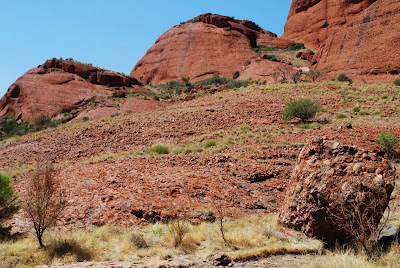Only one person I talked with in my office back in Sydney had been to the center of Australia. For everyone else it was a bit of a national guilt trip - the place that all the tourists go see but many - possibly even most - Australians never do. It's expensive, there's no beach, and it can be ungodly hot.
I suspect, too, that there had been some stupid publicity that there is little there other than Uluru, seen above (also called "Ayer's Rock" if you have outdated information). Bill Bryson had me thinking this way after reading "In a Sunburned Country". I'm not quite sure how he got so ignorant.
 |
| Kata Tjuta |
 |
| Uluru - smiling |
So seeing the red centre was epic - incredible sites, hikes, heat, camping, stars, wildlife, and kitsch.
 |
| Devil's Marbles |
 |
| Daly Water's pub |
What's sad is the disrespect that some of the people who have put forward so much time and energy into traveling to Uluru insist on. Pictured below are tourists climbing Uluru. This site has been estimated to have been used by local aboriginals for sacred purposes for some 10,000 years. The English came here in the 1870's, gave it a new name, conflicted with local tribes trying to settle the area, and ultimately drove posts up this side of the rock and started bringing in tourists in the 1930's. The Australian government eventually gave the site back to the aboriginals - but required that they lease it to the government for 99 years (yeah, don't know what's up with the British and the whole "99 years" bit).
This also included allowing tourists to continue to climb the site though this went very much against the sacred practices of the native peoples. So they've put up a large sign in languages from German to Japanese at the bottom of the climbing point explaining this in detail and asking people to please not climb. As you can see below, plenty of people ignore this entirely - actively choosing to disrespect and disregard what truly makes the site unique and powerful.
Other than wondering who really spends all that money just to come climb a big rock with an average view in the middle of the desert - it's a painful reminder of exactly how far the whole world has to come when it comes to respecting one another. Though the posts the English drove into the rock can't be removed and the iron oxide which has been rubbed off under people's feet will remain as a reminder of the wrong that was done, the active disrespect of the people from every corner of the globe who come here and do this is an ongoing statement.
 |
| Assholes |
-Hiked King's Canyon and Kata Tjuta is 36 degree + heat, walked around Uluru in the cooler morning
-camped under amazing stars for 2 nights
-mildly explored the hot, dusty and small town of Alice Springs
-only had 5 people on my tour up to Darwin, so got to know people pretty well :)
-got to stop at Wycliffe Well!! Most amazing alien kitsch in Australia! And an excellent gas stop.
-Explored Devil's marbles, experienced huge amounts of blow flies, a rare desert rain, and canoed beautiful Katherine Gorge
-got some decent historical insight: the telelgraph cable construction, one of the first Australian airports, and WWII significance of some of these sights after the attack on Darwin
And now, onward, to Darwin and Kakadu.
 |






No comments:
Post a Comment